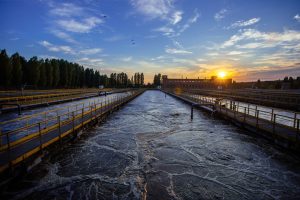In lieu of federal regulations for testing of per- and polyfluoroalkyl substances (PFAS) in biosolids, the St. Johns Riverkeeper is calling upon the state of Florida to mandate this testing, according to Central Florida Public Media (CFPM).
When sewage from households and businesses (and sometimes wastewater from industrial dischargers) is sent to a wastewater treatment plant, the liquids are separated from the solids, producing a semisolid, nutrient-rich product known as “sewage sludge” or “biosolids.” The EPA typically uses the term “biosolids” to mean sewage sludge that has been treated to meet the Agency’s regulatory requirements and is intended to be land applied as a soil conditioner or fertilizer.
The new testing requirements for biosolids called for by the St. Johns Riverkeeper comes on the heels of a report led by the Waterkeepers Alliance, which confirms that using “biosolids for fertilizer is linked to widespread contamination from toxic PFAS, or forever chemicals,” notes the CFPM.
This call for testing follows the EPA’s recent announcement of an interim final rule to extend the dates of the reporting period for data submitted on the manufacture of PFAS.
“Across the 19 states surveyed, including Florida, PFAS contamination was present in 80% of sites downstream from land where biosolids were applied, according to Waterkeepers Alliance. St. Johns Riverkeeper is a member of that national group and participated in an earlier phase of the study,” the CFPM explains.
The lack of federal standards reportedly makes it impossible to keep PFAS out of the environment.
“The number one most important thing is to keep the PFAS out of the system, and out of the discharges. And that requires industrial dischargers to control it at the source,” said Kelly Hunter Foster, a senior attorney at Waterkeeper Alliance, according to the CFPM. “And that requires federal standards.”
To learn more about EPA biosolid regulations, see 40 Code of Federal Regulations (CFR) Part 503, Standards for the Use or Disposal of Sewage Sludge, which regulates sewage sludge that’s applied to land, fired in a sewage sludge incinerator, or placed on a surface disposal site. The regulation includes pollutant limits, requirements for pathogen and vector attraction reduction, management practices, monitoring, recordkeeping, and reporting, among other requirements.
“40 CFR Part 503 applies to any person or treatment works that prepares sewage sludge, applies sewage sludge to the land, fires sewage sludge in an incinerator, and the owners and operators of surface disposal sites,” notes the EPA sewage sludge webpage.

